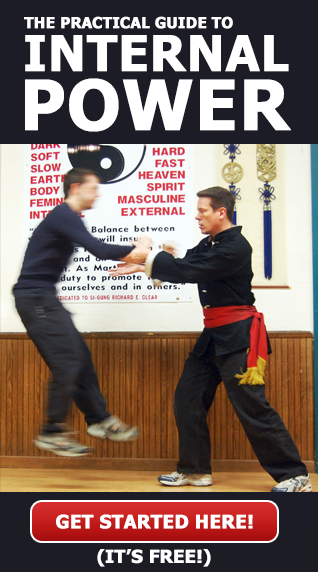Today we have the second part in a 2 part guest post by Brian Willis. He describes some of the reasons why there is such a huge difference in quality between Tai Chi that is taught publicly and the “in door” training that is very difficult to find. Brian mostly discusses Yang Style Tai Chi. Unfortunately this problem exists in all the major Tai Chi Styles as well as most other Chinese Kung Fu, Indonesian & Malaysian Silat, Okinawan Karate, Russian arts and many others. Click Here to read Part 1
This author is not a representative of Clear’s Tai Chi. His opinions are his own and may differ from those of Clear’s Tai Chi.
The defanging of Yang Style Tai Chi (part 2)
By Brian Willis
The Chen family had developed a very formidable style of kung fu (what we now call Chen-style tai chi chaun) during the Ming period, taught only within their family until the early 1800s. Then the art was opened for the first time to an outsider named Yang Lu-chan. Lu-chan left the Chen village, returning for a while to the village of Guang Ping where he modified what he had learned, creating the Yang style of tai chi chaun. He earned a reputation as a great master but only had three formal students – his sons, Yang Pan-hou & Yang Chien-hou, and, later, a promising young artist in the Chen style named Wu Yu-hsiang (whose art later branched off into one of the two Wu styles (known now as Wu/Hao) & the Sun style of tai chi chaun, but that’s a different topic!)
Yang Pan-hou proved to be an even greater fighter than his father and his kung fu soon drew the attention of the emperor. The emperor asked Pan-hou to teach his art to the imperial family, a request that simply could not be refused. Not wanting to reveal to the hated Manchu the greatest strengths of the until-then-secret Han-developed martial art of tai chi chaun, Pan-hou created a new form. He lengthened the form from 64 movements to 106 movements but, more significantly, he removed much of the fa jing and reeling elements from the form. Still a powerful martial art but a pale shadow of the original, this was what was taught to the Manchu royal family and, later, to the palace guards.
After the Xinhai revolution and the fall of the Qing Dynasty, the leaders of the Republic of China recognized that the population needed physical exercise. Drawing primarily from the martial art most familiar to them (the watered-down version of the Yang style which had been in the political spotlight for half a century), a further simplified version was developed and began to be taught to the masses. The Republic of China struggled, however, and later fell to the communists (who essentially reverted to dynastic imperialism, but that’s a different topic!) Under the communist People’s Republic of China, the leadership again recognized the need for a national program of physical fitness.
In 1956, the Chinese Sports Committee developed a new form of exercise by reducing the Yang style to only 24 movements, known as the 24 posture simplified form and often referred to as the Beijing form or Beijing style. No longer taught as a martial art (although still containing many authentic movements at its core, still developing chi and still employing chi gung principles), this form was used by the government for general exercise and was taught in “re-education” camps, and later in all schools.
As a result, while the Chen, Guan Ping Yang (or traditional Yang), Wu, Sun, etc., styles of tai chi chaun were still being taught to small and dedicated groups of students, hundreds of millions of Chinese citizens were being taught the exercise program known as tai chi. As one might expect, many of these citizens continued their exercises after leaving China (where it is still being taught to school children) and it thus found its way into popular Western culture because of its genuine health benefits. This emasculated version of “tai chi” is the slow-motion “dance” commonly seen in parks, senior centers & YMCAs across the nation, and is what is most commonly taught by tai chi instructors outside the much smaller martial art community.

For those of you who are new to Tai Chi this article may raise a couple questions like:
“I’m new to Tai Chi. How do I tell the difference between good tai chi and bad?”
How to Find a Tai Chi Instructor will answer this question.
“I’m only interested in Tai Chi for Health. Do I still need to worry about this problem?”
Yes, read this article by Sigung Clear to learn why: The difference between Healthy Tai Chi & Fighting Tai Chi
“Does this problem of widespread poor quality instruction only exist in Yang style?”
No, These problems exist in all major styles of Tai Chi. (and many other martial arts.) There are highly skilled masters in all styles of Tai Chi out there. However finding them and getting them to teach high quality information is a costly and time consuming endeavor.
Fortunately, if you’re reading this website you have already found an easily accessible source of high quality info on Tai Chi.
Our goal is to raise the standards of Tai Chi training across the country by educating people on what Tai Chi is, what is possible with proper training and how to get there.
Great article, thank you. I live and teach Taijiquan in Bali Indonesia, center of yoga, massages and spa treatments. Very few people here are interested in the discipline required to stidy Taijiquan. Look for a teacher who is excited about their art, and has actually read the Tao Te Ching and other Taiji classics. Most commercial spas and fitness gyms only offer cosmetics and brute force. Tai Chi for Health (Taijiqigong) can lead you to Pushing Hands, the gateway to real Taijiquan.